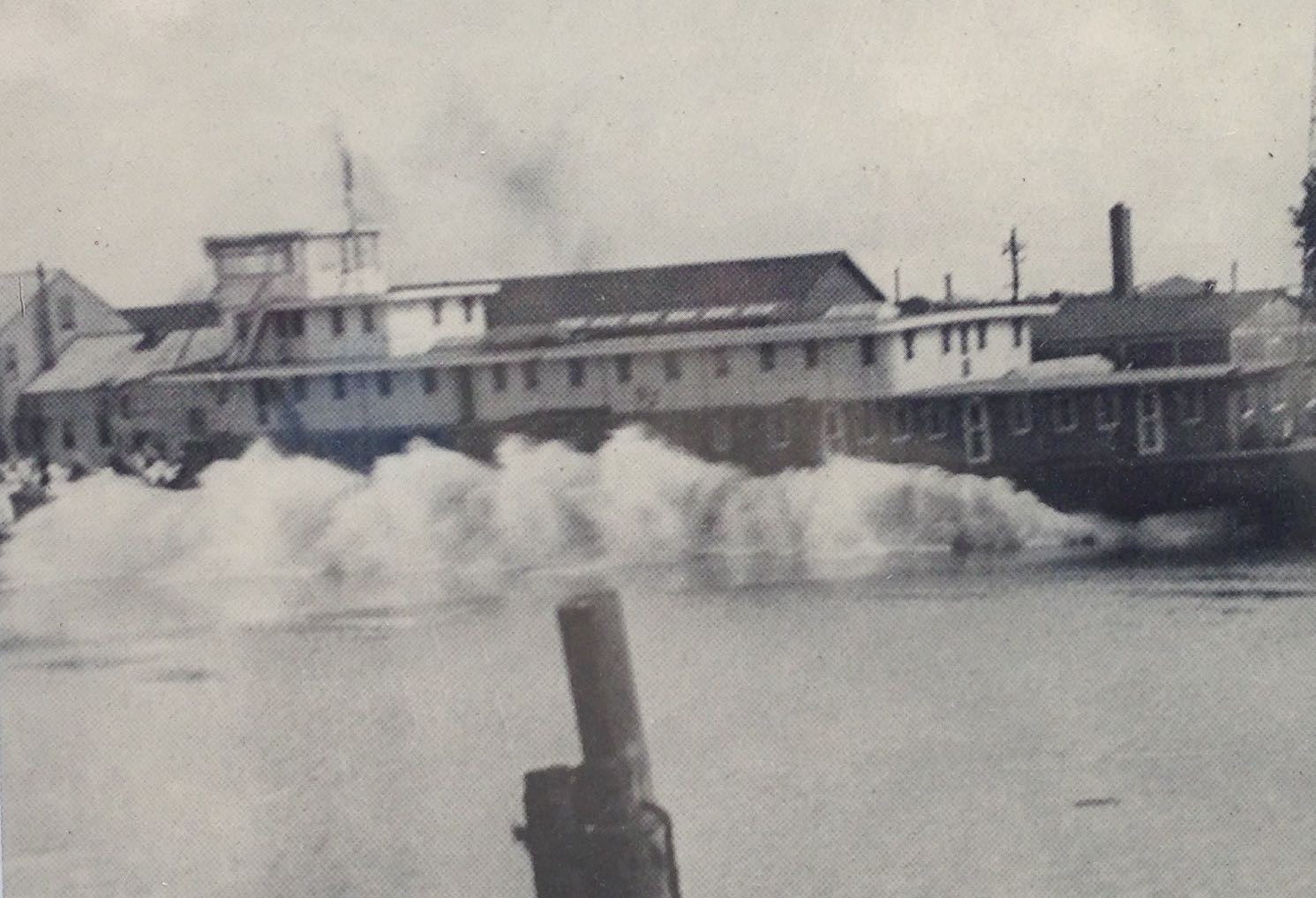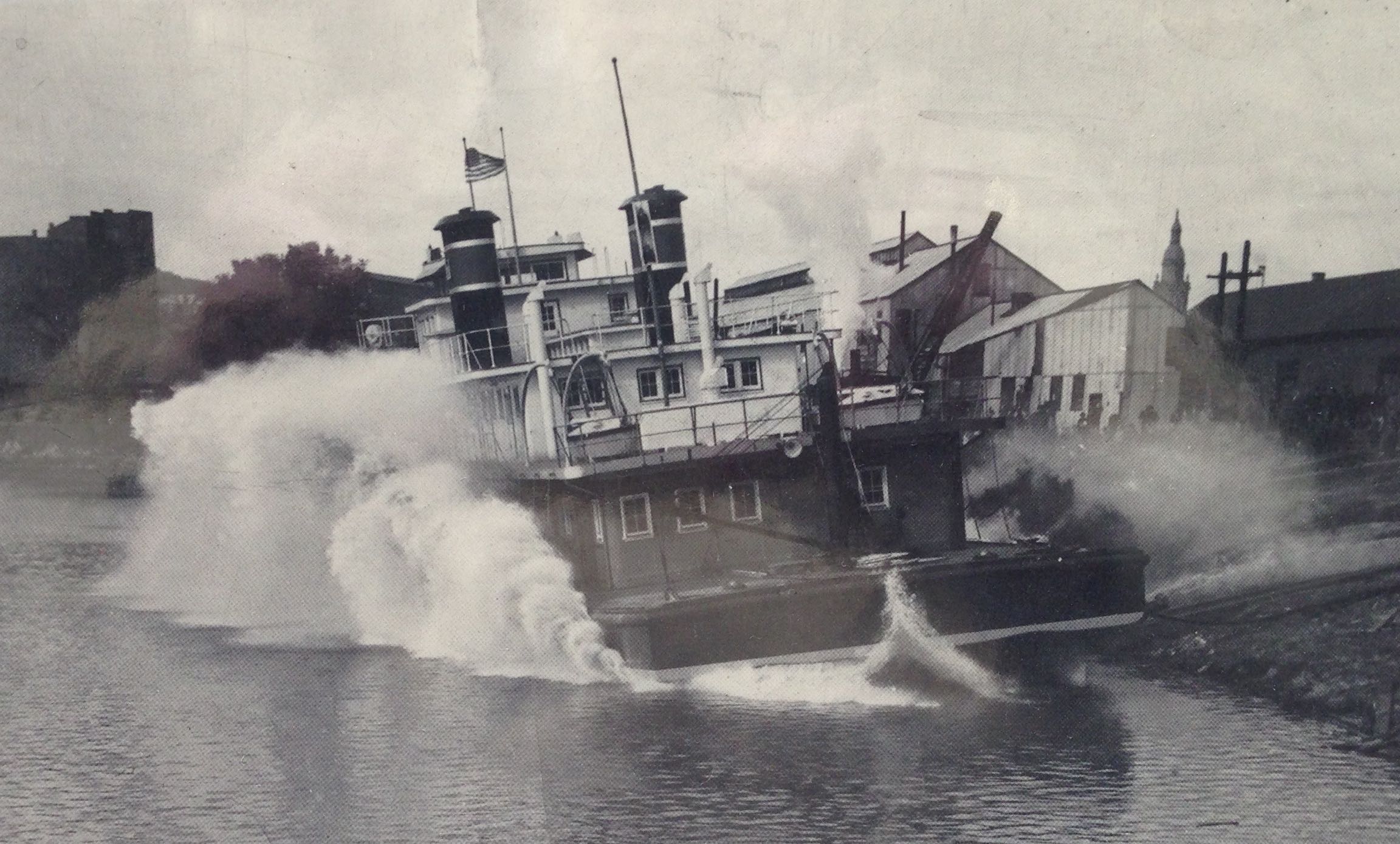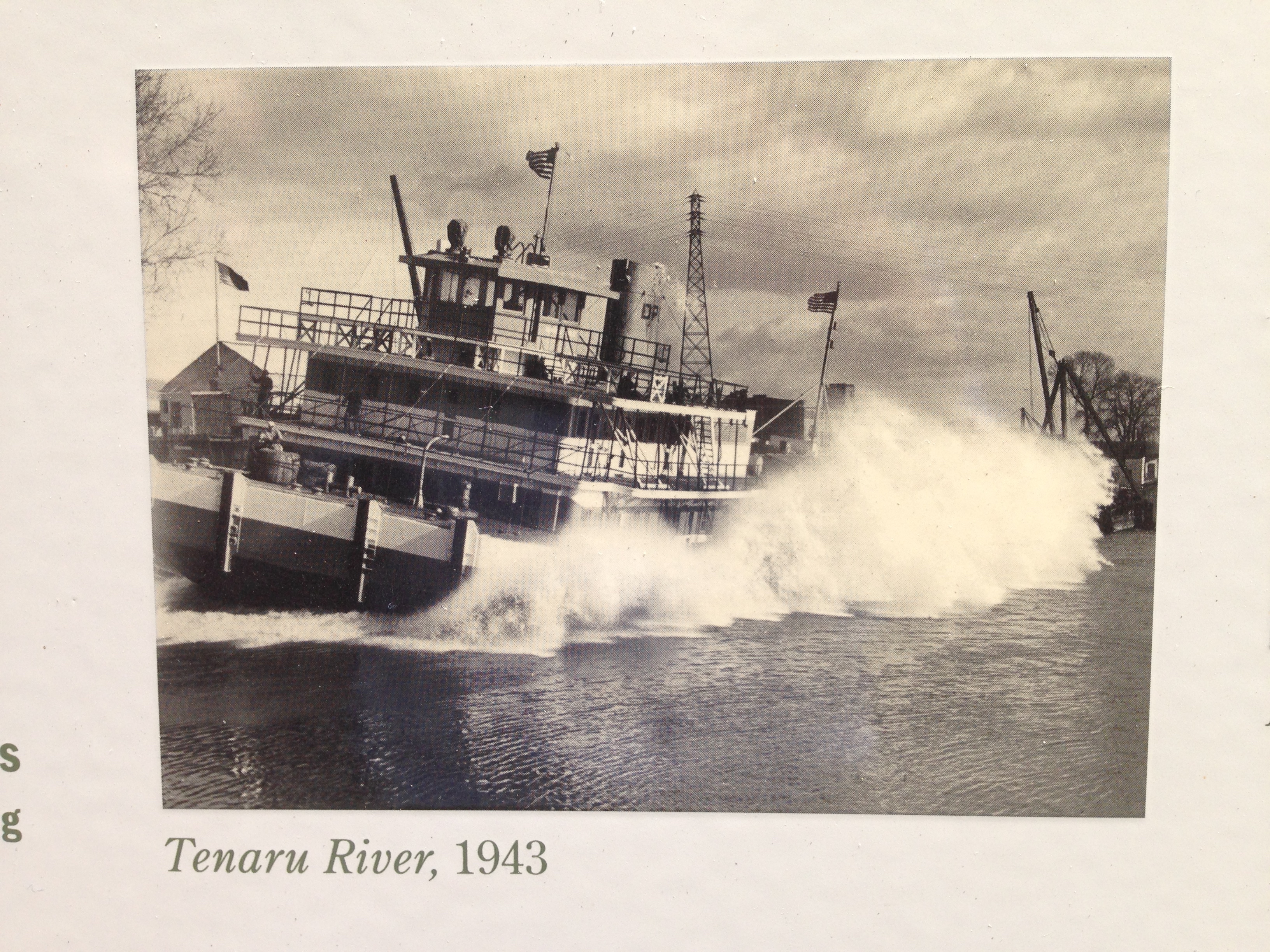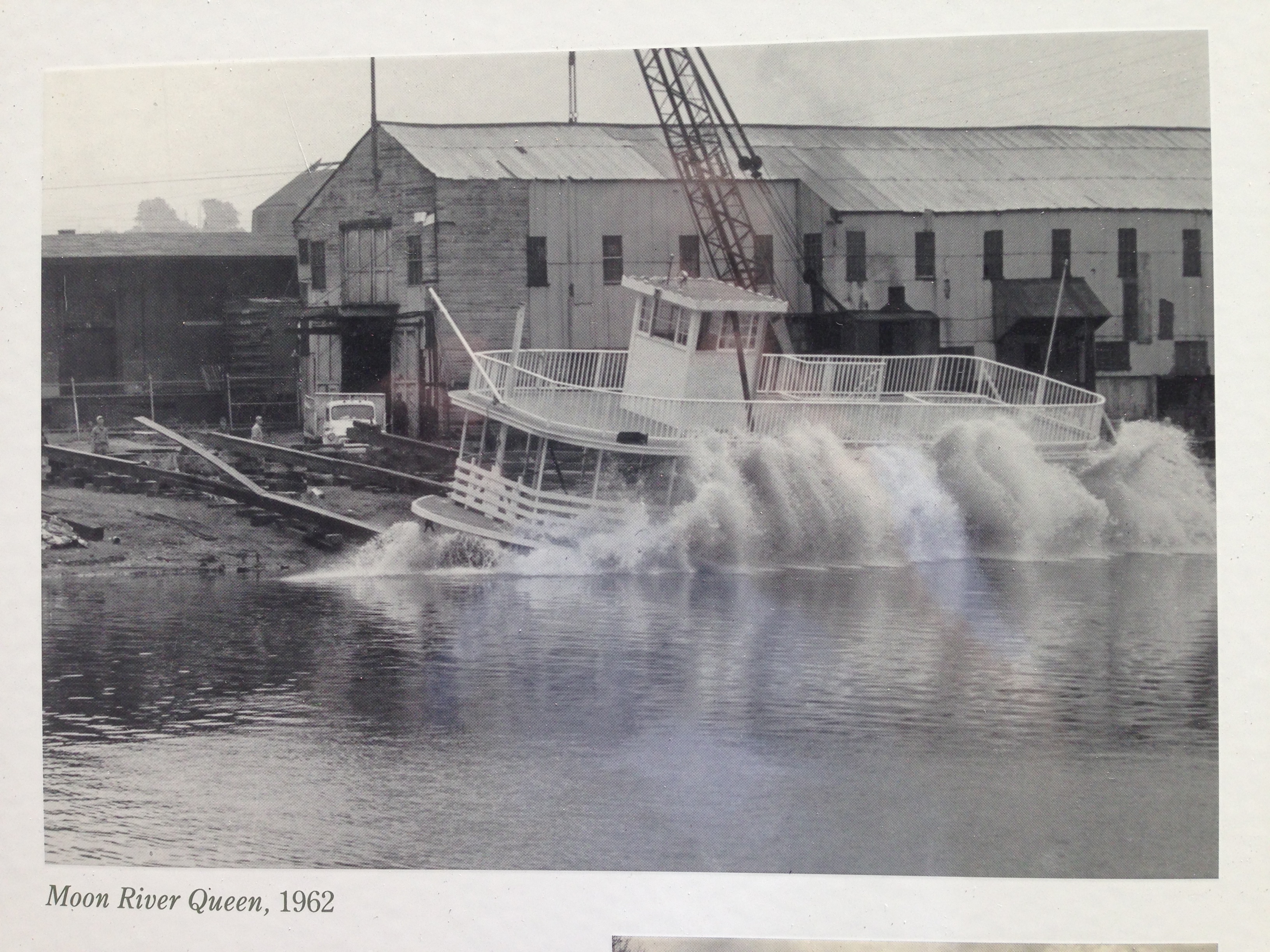|
|
| (42 intermediate revisions by the same user not shown) |
| Line 1: |
Line 1: |
| [[Image:imp914.jpg|left|thumb|250px|]]BOAT BUILDING. One of Dubuque's premier industries. The geographic location of Dubuque midway between St. Louis and St. Paul and the protected harbor (claimed by river pilots as the Upper Mississippi's best), were important reasons for the development of the ship manufacturing industry. | | [[Image:hoover1931.jpg|left|thumb|250px|Launching the Herbert Hoover, 1931. Photo courtesy: National Mississippi River Museum and Aquarium]] |
| | [[Image:delcommune37.jpg|left|thumb|250px|Launching the Del Commune, 1937. Photo courtesy: National Mississippi River Museum and Aquarium]] |
| | [[Image:tenaruriver.jpg|left|thumb|250px|Launching the Tenaru River, 1943. Photo courtesy: National Mississippi River Museum and Aquarium]] |
| | [[Image:moonriverqueen.jpg|left|thumb|250px|Launching the Moon River Queen 1962. Photo courtesy: National Mississippi River Museum and Aquarium]]BOAT BUILDING. One of the primary industries to develop in Dubuque, boat building really began after the [[CIVIL WAR]]. Prior to that, boats tended to be small and for local use. Larger boats were constructed along the Ohio River or the lower [[MISSISSIPPI RIVER]]. |
|
| |
|
| Dubuque pioneered the evolution of boats from wooden hulls to iron. In 1870 the first keel was laid for an iron vessel in Dubuque. The manufacturer, [[IOWA IRON WORKS]], was founded in 1851 by [[ROUSE, Hammond|Hammond ROUSE]] and [[TREDWAY, Alfred|Alfred TREDWAY]]. This first steamboat was named the "Clyde," for the home in Scotland of [[HOPKINS, William|William HOPKINS]], a builder of ironclads during the [[CIVIL WAR]] and master mechanic at Rouse and Dean, another pioneer Dubuque boat builder. The 96-foot-long Clyde, the first iron-hulled boat built for the Upper [[MISSISSIPPI RIVER]], was the second boat built for the logging trade.
| | Beginning around 1870, boat building in Dubuque became a booming industry. On August 13, 1920 the "Frisco" became the ninety-ninth steamer constructed in the city. |
|
| |
|
| [[Image:imp518.jpg|right|thumb|250px|Working on a boat at Eagle Point. Charles Voltz-father and Carl Voltz-son. Photo courtesy: Bob Reding]]In 1871 Rouse and Dean constructed the Dubuque Marine Ways, the largest of its kind north of St. Louis and considered the best on the Mississippi River, at [[EAGLE POINT]]. In 1874 [[REYNOLDS, Joseph "Diamond Jo"|Joseph "Diamond Joe" REYNOLDS]] established a boatyard at Eagle Point for constructing wooden-hulled steamers. Iron and steel, supplied by the Iowa Iron Works from its foundry on 9th and Washington [[STREETS]], were carried to the river for assembly during the thirty-seven-year life of the business. Of these yards, the Iowa Iron Works developed as the major boat builder in the city.
| | Most were constructed by the following: |
|
| |
|
| Beginning in 1882 the U.S. Army Corps of Engineers worked at improving the potential of the Dubuque [[ICE HARBOR]]. The 1885 completion of the project enhanced the site of Dubuque for the construction of iron and later steel-hulled boats. In 1895 the Iowa Iron Works relocated their shipyard to the Ice Harbor.
| | See: [[JOHNSON AND KALKE]] |
|
| |
|
| In 1901 a contract was signed for the construction of the [[SPRAGUE|"SPRAGUE,"]] the largest steam stern wheel towboat in the history of the Mississippi. Despite the death in 1902 of William Hopkins, the year proved the company's best with the Sprague nearly completed and the keel laid for the "Pelican," an enormous transfer steamboat.
| | See: [[DIAMOND JO LINE]] |
|
| |
|
| Iowa Iron Works of Dubuque constructed craft for every use. The King of Siam ordered an iron yacht that was delivered to him in 1876. The "Queen" was launched in 1884 for excursions on northwest Iowa's Lake Okoboji and was still in use through the 1960s.
| | See: [[IOWA IRON WORKS]] |
|
| |
|
| [[Image:yokum.jpg|left|thumb|250px|B. F. YokumPhoto courtesy: Bob Reding]]
| | See: [[DUBUQUE BOAT AND BOILER WORKS]] |
| [[Image:albatross.jpg|right|thumb|250px|Photo courtesy: Bob Reding]] | |
|
| |
|
| The "J. K. Graves," launched in 1885 by the Iowa Iron Works, was a giant raft-boat used to push rafts of logs to the mills. Steel-hulled packets for carrying freight and passengers included the "Cherokee," the company's first boat of this type. The "Cherokee" boasted electric lights and the capability of carrying up to one thousand passengers. Constructing the "Ferdinand Herold" required 125 workers and cost $80,000. Railroad ferries with track laid on the deck were constructed to transport trains across the Mississippi where bridges were temporarily out of service. At an average construction cost of $250,000 each, the "L. S. Thorne" (1898), "Pelican" (1902), "Albatross" (1907) and "B. F. Yokum" (1910) and the “Willow” (1924) were important contributors to the Dubuque economy.
| |
|
| |
|
| | '''Some of the boats were constructed by unknown builders. These include the:''' |
|
| |
|
| [[Image:boats-1.gif|left|thumb|150px|]]Willow, a 200-foot, 1,070 ton, side paddlewheel river tender, was built by the Dubuque Boat & Boiler Works for the US Lighthouse Service for service on the Mississippi River. Commissioned in 1924, she was decommissioned and transferred to the Army Corps of Engineers in 1945. Her maximum speed was 7.5 knots and her economic cruising speed was a 4.0 knots. She was stationed at Memphis.
| | Jo Gales--a ferry boat between Dubuque and Dunleith owned and operated by Charles H. Merry. |
|
| |
|
| | The Douglas Boardman--a passenger steamer with wooden hull built by W. J. Young |
|
| |
|
| | The D. W. Hewitt--freight boat constructed in 1865 |
|
| |
|
| | The Lansing--ferry from Dubuque to East Dubuque built by J. R. Graves, A. F. Jaeger, and J. Rhomberg |
|
| |
|
| | The A. J. Dorchester--a freight boat constructed in 1869 by H. J. Reed |
|
| |
|
| Concern about the condition of the U.S. Navy led to Congressional calls for modernization at the end of the nineteenth century. In 1891 the Iowa Iron Works received the contract to build Torpedo Boat No.2. Named the "Ericsson," the boat was outfitted with state-of-the-art equipment and saw service during the Spanish-American War.
| | The General Hyde Clark--a tow boat built in 1870 |
|
| |
|
| During the trial runs of the "Ericsson," the pistons broke because they had been built too light. The Navy penalty of $17,000 forced the company out of business. Senator [[ALLISON, William Boyd|William ALLISON]] rescued the firm by attaching an amendment to an appropriations bill stating that the Navy would repay the money to the bankrupt Dubuque company. The repayment was used in 1904 to reorganize the company as the [[DUBUQUE BOAT AND BOILER WORKS]].
| | J. A. Rhomberg--Eagle Point ferry built by Fred Schreiner in 1870 |
|
| |
|
| [[Image:boatboiler.jpg|left|thumb|350px|Check used by the Dubuque Boat and Boiler Works. Photo Courtesy: Bob Reding]]
| | Julia--built in 1871 as a passenger steamer with a wooden hull. |
| The Dubuque Boat and Boiler Works, the second oldest boat manufacturing firm in the United States and the only one of its kind on the Mississippi River, was used during [[WORLD WAR I]] for the manufacture of tows, barges, dredges, submarine chasers, and Coast Guard cutters. An estimated twenty boats were built for use during [[WORLD WAR II]]. Two new types were mine layers and tenders.
| |
|
| |
|
| [[Image:launchingboat.jpg|right|thumb|350px|A boat ready for the final touches was slid down greased rails into the water and then held from drifting off by workmen with ropes until it could be secured. Photo Courtesy: Bob Reding]]
| | The Fire Fly--built in 1875 as a tow boat by Laura E. Smith |
|
| |
|
| With the end of the war, Dubuque Boat and Boiler Works converted to the production of pleasure craft and was soon rated as one of the major excursion boat manufacturers in the nation. Employment reached two hundred men employed year-round. Business gradually declined. The boatyard had to be closed in May 1972.
| | The Wineconne--a U. S. boat built in 1875 |
|
| |
|
| During its illustrious life, the boat building industry in Dubuque pioneered many innovations. "Shoal water propellers," designed by John Dowler of the Iowa Iron Works, saved fuel and allowed boats to pass through very shallow water. Pioneering the use of these iron propellers in 1872, the Iowa Iron Works mounted them above the water line on the boat's stem. The first boat fitted with them was the "J. G. Chapman," a steamer built for the lumber trade. Reaction to the device, dubbed "Dowler's Humbug," was generally negative.
| | The James McMurchy--a ferry at Specht's Ferry built by Mrs. Specht in 1876 |
|
| |
|
| [[Image:Boats-3.gif|left|thumb|150px|]]Dogwood, a 114-foot river tender, was constructed by the Dubuque Boat & Boiler Works Company. Commissioned in 1941, she served until 1989 and was stationed at Vicksburg, MI and later Pine Bluff, AR. She escorted the NASA rocket barge Palaemon on three occasions and helped in the cleanup operation along the gulf coast after hurricane Betsey.
| | The Julia--built in 1876 as a tow boat |
|
| |
|
| | The Key City--ferry to Dunleith built in 1876 |
|
| |
|
| | The Delos--a U. S. boat built in 1881 |
|
| |
|
| | The Fury--a U. S. boat built in 1881 |
|
| |
|
| Boat builders realized that paddle wheels met great resistance as they left the water. To increase boats' propulsion, feathering paddlewheels were designed which enabled the buckets to remain vertical when entering the water and then turn when coming out. While more efficient, the concept proved complicated and difficult to sell. The swivel action could be ruined with just one grounding of the paddlewheel on a snag or the river bottom.
| | The Wabash--built in 1881 as a passenger steamer |
|
| |
|
| [[Image:boats-3.gif|left|thumb|250px|Andrew Carnegie]]Blackberry, a 65-foot inland buoy tender, was constructed by the Dubuque Boat & Boiler Company. She entered service in 1946 and has been stationed in Sheffield, AL, Paris, TN, and Southport, NC. She remained unnamed until 1963 when the Coast Guard decided to name all vessels 65-feet in length or more. Prior to this any vessel of less than 100-feet was not named.
| | The City of Winona--built in 1882 as a passenger steamer |
|
| |
|
| [[Image:imp354.jpg|left|thumb|250px|Steamer Albatross. Photo courtesy: Bob Reding]] | | W. J. Young, Jr.--built in 1882 as a passenger steamer |
| | |
| | The George L. Bass--built in 1885 as a passenger steamer for P. Gilmartin and Henry Schroeder |
| | |
| | The Glenmont--built in 1885 by J. W. Van Sant |
| | |
| | The May Stewart--built in 1885 as a tow boat |
| | |
| | The Rose--built in 1886 as a passenger steamer |
| | |
| | The Lotus--built in 1886 as a tow boat |
| | |
| | The Jeanne Hopkins--built in 1887 by M. H. Moore |
| | |
| | The Reindeer---built in 1888 by the Mississippi Towing Company |
| | |
| | The Chester--built in 1888 |
| | |
| | The Jessie B.--built in 1891 by V. A. Bigelow as a passenger steamsr |
| | |
| | The Germania--built in 1892 as a passenger steamer |
| | |
| | The Lalla--built in 1893 as a passenger steamer |
| | |
| | The Quick Step--built by V. A. Bigelow in 1893 as a passenger steamer |
| | |
| | The Betsy Ann--built in 1899 as a passenger steamer |
| | |
| | The Lillian--built in 1891 as a passenger steamer |
| | |
| | The Zalus Davis--built in 1894 as a passenger steamer |
| | |
| | The Orian--built in 1894 by the Dillon Bros. as a passenger steamer |
| | |
| | The Quincy--built by L. G. Dolson in 1896 as a passenger steamer |
| | |
| | The Vulcan--a U. S. boat built in 1897 |
| | |
| | The Bob--built in 1905 as a tow boat |
| | |
| | The Ghost--built in 1903 as a pleasure boat |
| | |
| | The Frentress--built in 1903 as a passenger boat |
| | |
| | The J. R.--built in 1905 as a passenger boat |
| | |
| | The Eclipse--built in 1905 |
| | |
| | The Potosi--built in 1905 as a passenger steamer |
| | |
| | The Twilight--built in 1908 as a passenger boat |
| | |
| | |
| | See: [[DIAMOND JO BOATYARD]] |
| | |
| | --- |
| | |
| | Source: |
| | |
| | 1. "Dubuque, A Boat Building Centre," ''Telegraph Herald,'' August 21, 1910, p. 10 |
|
| |
|
| [[Image:imp355.jpg|right|thumb|250px|Steamer B.F. Yoakum. Photo courtesy: Bob Reding]]
| |
|
| |
|
|
| |
|
| [[Category: Industry]] | | [[Category: Industry]] |
| [[Category: Postcards]]
| |

Launching the Herbert Hoover, 1931. Photo courtesy: National Mississippi River Museum and Aquarium

Launching the Del Commune, 1937. Photo courtesy: National Mississippi River Museum and Aquarium

Launching the Tenaru River, 1943. Photo courtesy: National Mississippi River Museum and Aquarium

Launching the Moon River Queen 1962. Photo courtesy: National Mississippi River Museum and Aquarium
BOAT BUILDING. One of the primary industries to develop in Dubuque, boat building really began after the CIVIL WAR. Prior to that, boats tended to be small and for local use. Larger boats were constructed along the Ohio River or the lower MISSISSIPPI RIVER.
Beginning around 1870, boat building in Dubuque became a booming industry. On August 13, 1920 the "Frisco" became the ninety-ninth steamer constructed in the city.
Most were constructed by the following:
See: JOHNSON AND KALKE
See: DIAMOND JO LINE
See: IOWA IRON WORKS
See: DUBUQUE BOAT AND BOILER WORKS
Some of the boats were constructed by unknown builders. These include the:
Jo Gales--a ferry boat between Dubuque and Dunleith owned and operated by Charles H. Merry.
The Douglas Boardman--a passenger steamer with wooden hull built by W. J. Young
The D. W. Hewitt--freight boat constructed in 1865
The Lansing--ferry from Dubuque to East Dubuque built by J. R. Graves, A. F. Jaeger, and J. Rhomberg
The A. J. Dorchester--a freight boat constructed in 1869 by H. J. Reed
The General Hyde Clark--a tow boat built in 1870
J. A. Rhomberg--Eagle Point ferry built by Fred Schreiner in 1870
Julia--built in 1871 as a passenger steamer with a wooden hull.
The Fire Fly--built in 1875 as a tow boat by Laura E. Smith
The Wineconne--a U. S. boat built in 1875
The James McMurchy--a ferry at Specht's Ferry built by Mrs. Specht in 1876
The Julia--built in 1876 as a tow boat
The Key City--ferry to Dunleith built in 1876
The Delos--a U. S. boat built in 1881
The Fury--a U. S. boat built in 1881
The Wabash--built in 1881 as a passenger steamer
The City of Winona--built in 1882 as a passenger steamer
W. J. Young, Jr.--built in 1882 as a passenger steamer
The George L. Bass--built in 1885 as a passenger steamer for P. Gilmartin and Henry Schroeder
The Glenmont--built in 1885 by J. W. Van Sant
The May Stewart--built in 1885 as a tow boat
The Rose--built in 1886 as a passenger steamer
The Lotus--built in 1886 as a tow boat
The Jeanne Hopkins--built in 1887 by M. H. Moore
The Reindeer---built in 1888 by the Mississippi Towing Company
The Chester--built in 1888
The Jessie B.--built in 1891 by V. A. Bigelow as a passenger steamsr
The Germania--built in 1892 as a passenger steamer
The Lalla--built in 1893 as a passenger steamer
The Quick Step--built by V. A. Bigelow in 1893 as a passenger steamer
The Betsy Ann--built in 1899 as a passenger steamer
The Lillian--built in 1891 as a passenger steamer
The Zalus Davis--built in 1894 as a passenger steamer
The Orian--built in 1894 by the Dillon Bros. as a passenger steamer
The Quincy--built by L. G. Dolson in 1896 as a passenger steamer
The Vulcan--a U. S. boat built in 1897
The Bob--built in 1905 as a tow boat
The Ghost--built in 1903 as a pleasure boat
The Frentress--built in 1903 as a passenger boat
The J. R.--built in 1905 as a passenger boat
The Eclipse--built in 1905
The Potosi--built in 1905 as a passenger steamer
The Twilight--built in 1908 as a passenger boat
See: DIAMOND JO BOATYARD
---
Source:
1. "Dubuque, A Boat Building Centre," Telegraph Herald, August 21, 1910, p. 10





